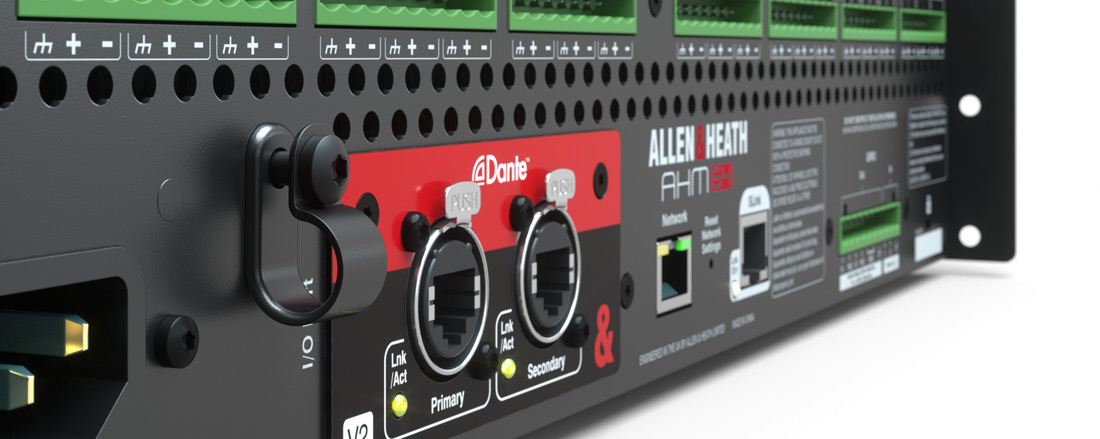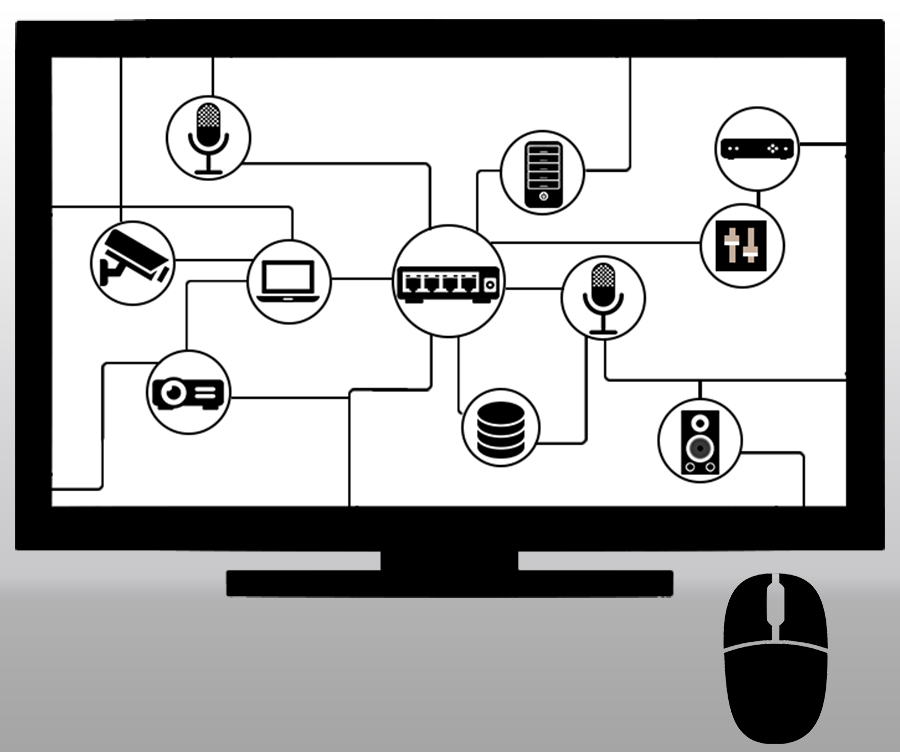Okay, folks, this post is for bit-heads: network engineers and system administrators. The rest of you can take a coffee break [smile]. So what is Dante anyway? Well, we’re glad you asked. . .

Dante is a revolutionary technology solution for distributing audio—and now video—over a standard one-Gigabit Ethernet/IP network. Designed and developed by the Australia-based company, Audinate, the Audio/Video-over-Internet-Protocol (AVoIP) solution comprises hardware, software, and inter-computer communication protocols.
The Dante AV technology solution replaces all your rigid, cumbersome, heavy, audio and video cabling with a flexible Ethernet-based local area network (LAN) constructed of lightweight, multi-purpose, fiber-optic or Cat 5/6 Ethernet cables.
With Dante AV, you can send all your audio and video signals to any connected device located anywhere on the LAN.
Now for the geeky stuff. . .

PART I: How to Add Dante Audio to Your Local Area Network
So, let’s start with the audio part. We’ll cover the video portion in PART II. Here’s what you need to know when you set up your Dante audio-over-IP solution.
Dante uses DHCP, when available, to assign IP addresses to network devices. Dante will auto-assign an IP address to each device as though it were a PC or Mac.
- Dante devices will continue to ‘look’ for DHCP even after auto-assigning an IP address.
- Some (not all) Dante devices permit static IP address assignment.
- To assist with multicast management, Dante implements the IGMPv3/v2 routing protocol.
- IGMP (Internet gateway management protocol) support is not required within the network. Dante provides IGMP to make it simpler to integrate Dante into a mixed-use network.
- Dante can use DiffServ QoS (quality of service) to tag packets. The Dante tags can be integrated into an existing IT network QoS scheme:
| Priority | Usage | DSCP Label | Hex | Decimal | Binary |
| High | Time critical PTP events | CS7 | 0x38 | 56 | 111000 |
| Medium | Audio, PTP | EF | 0x2E | 46 | 101110 |
| Low | (Reserved) | CS1 | 0x08 | 8 | 001000 |
| None | Other traffic | BestEffort | 0x00 | 0 | 000000 |
The table above shows the Dante QoS Scheme
- QoS is only required for 100-Mbps or mixed 1-Gbps/100-Mbps networks. It can be helpful on mixed-use networks. It is not required for dedicated, all-gigabit, Dante-only networks. When used, it must be configured with strict priority.
- Note that the QoS could be re-marked, provided that the PTP packets still receive high priority.
For additional guidance on setting up Dante audio-over-Ethernet and integrating it into your LAN. . .
Get the Audinate Publication…
>>Adding Dante to Your Network (PDF)
PART II: Adding Dante Video Distribution to Your Local Area Network
So, let’s imagine you are an IT manager with a Dante audio network in place. Now it’s time to add video-over-IP to your Dante setup.
The Patton FiberPlex FPX6000 AVoIP gateway makes it easy. All you have to do (in most cases) is connect the FPX6000 transmitters and receivers to the right devices on your 1-Gbps Ethernet LAN.
Compared with Dante audio-only technology, Dante AV employs the same Dante Controller Software, network protocols, and routing capabilities (unicast and multicast). Now, in addition to eight audio channels, Dante AV delivers high-quality video.
So, let’s cover the key points you must consider as an IT manager designing your Dante AV network.
QoS at the Switch Level: QoS is not required for Dante audio network speeds under 100 Mbps. However, since Dante AV installations always run at 1 Gbps or faster, QoS is a must. Patton recommends Pro AV 802.3bt switches for all Dante AV PoE installations.
IGMP Packet Snooping: Dante has implemented IGMP to enhance multicast and mixed-use environments that are typically required in Dante AV installations, so IGMP packet snooping is a must for successful Dante AV implementation. (Multicast, in this context, is not implemented in the switch, but rather in Dante Controller.
EEE Switches: Most IT managers are familiar with Energy Efficient Ethernet switches. Because they can cause poor synchronization performance and occasional dropouts, these devices should be avoided in Dante networks. Let us be perfectly clear: Never use EEE switches in Dante AV installations!
Bandwidth: One of the clear advantages of Dante AV is visually lossless 4k video over a 1-Gbps network. Dante AV will consume considerably more bandwidth than Dante audio, which requires about 6 Mbps on average Still, the bandwidth requirement for high-quality video with Dante AV is surprisingly small. A 4k60p 4:4:4 10-bit video signal will consume ~911 Mbps per port. A 4k30p 4:4:4 10 bit signal requires ~506 Mbps. Reducing the frame rate and color space can significantly reduce bandwidth requirements, see table below:
| Dante AV Bandwidth Estimates (JPEG 2000) | ||||
| Video Signal | Resolution | Frame Rate | Bit Depth | Typical Bandwidth (Mbps) |
| 4K60p 4:4:4 | 4096×2160 | 60 | 10 | 911 |
| 4K60p 4:4:4 | 4096×2160 | 60 | 8 | 810 |
| 4K60p 4:2:2 | 4096×2160 | 60 | 10 | 675 |
| 4K60p 4:2:2 | 4096×2160 | 60 | 8 | 540 |
| 4K60p 4:2:0 | 4096×2160 | 60 | 10 | 506 |
| 4K60p 4:2:0 | 4096×2160 | 60 | 8 | 405 |
| 4K30p 4:4:4 | 4096×2160 | 60 | 10 | 506 |
| 4K30p 4:4:4 | 4096×2160 | 60 | 8 | 405 |
| 4K30p 4:2:2 | 4096×2160 | 60 | 10 | 337 |
| 4K30p 4:2:2 | 4096×2160 | 60 | 8 | 270 |
| 4K30p 4:2:0 | 4096×2160 | 60 | 10 | 253 |
| 4K30p 4:2:0 | 4096×2160 | 60 | 8 | 203 |
| 1080 60p 4:4:4 | 1920×1080 | 60 | 10 | 253 |
| 1080 60p 4:4:4 | 1920×1080 | 60 | 8 | 203 |
| 1080 60p 4:2:2 | 1920×1080 | 60 | 10 | 169 |
| 1080 60p 4:2:2 | 1920×1080 | 60 | 8 | 135 |
| 1080 60p 4:2:0 | 1920×1080 | 60 | 10 | 126 |
| 1080 60p 4:2:0 | 1920×1080 | 60 | 8 | 101 |
Inter-Switch Connections: When we do the math for delivering Dante AV over 1-Gbps switch ports, the need for 10-Gbps links between Dante AV switches becomes apparent. Depending on the age of your original Dante installation, 10-Gbps connections may not have been available or cost-effective. Fortunately, time and scale have solved those issues. So, for Dante AV installations, upgrading to or installing 802.3bt Pro AV switches with 10Gbps uplinks is a best practice.
Multicast: Most Ethernet/IP engineers are familiar with unicast, fanout, and multicast. You will also know in some cases audio fanout can work within the limitations of your network. However, Dante AV will not be a happy citizen in most fanout implementations, so we do not recommend it. For one-to-many scenarios, multicast is the best way forward. Choosing the right video resolution, color space, and bit depth are also crucial.
When designing and planning your Dante AV installation, doing good math in your network topology and adding the right number of FPX6000 receivers will be the key to successfully implementing a robust Dante AV experience.
